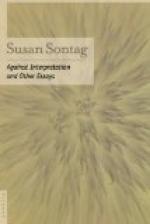|
This section contains 740 words (approx. 2 pages at 400 words per page) |

|
Against Interpretation Summary & Study Guide Description
Against Interpretation Summary & Study Guide includes comprehensive information and analysis to help you understand the book. This study guide contains the following sections:
This detailed literature summary also contains Topics for Discussion on Against Interpretation by .
The following version of this book was used to create this study guide: Sontag, Susan. Against Interpretation: And Other Essays. Farrar, Straus & Giroux, 1969. Fourth Printing.
Beginning with a discussion of the problem of interpretation and hermeneutics in cultural criticism, Susan Sontag, herself an American critic, argues for a mode of aesthetic appreciation that draws on classical understandings of formalism, draws special attention to a work of art's sense of style, and proceeds with an unprecedented sensitivity to sensory excitation and an openness to experience. Part 1 contains two of her more conceptual or theoretical essays, "Against Interpretation" and "On Style." In these pieces, Sontag argues for what she calls an erotics of art to replace dominant modes of interpretation in cultural criticism and makes a modest plea for critic and art appreciators alike to pay closer attention the ways that style is present (or absent) in art works.
Part 2 discusses a swathe of European intellectuals, providing critical reviews of their work as well as expository introductions for her decidedly American audience. These figures include the religious thinker Simone Weil, French philosophers Albert Camus and Jean-Paul Sartre, the French anthropologist Claude Levi-Strauss, the Hungarian literary critic Georg Lukacs, and the French writer Nathalie Saurrate. In each essay and with each individual Sontag selects and reviews a single work that is, on her reading, especially representative of the author's entire body of work.
Part 3 moves to the arena of the theater. In this group of essays, Sontag discusses single dramatic productions like Rolf Hochhuth's "The Deputy" and Peter Weiss's "The Persecution and Assassination of Marat as Performed by the Inmates of the Asylum at Charenton under the Direction of the Marquis de Sade" as well as single, influential playwrights like Eugene Ionesco. The essay "The Death of Tragedy" takes a broad step back and examines the state of the dramatic form of theater itself and its relationship to the Western self through the cipher of Lionel Abel's delimitation of the genre of tragedy and his idea of metatheater. "Going to theater, etc." reads like a short journal of Sontag's theater and movie going experiences in the summer of 1964, examining figures as diverse as James Baldwin, Arthur Miller, and Stanley Kubrick, and highlighting the importance of single cinematic and theatrical works like Charlie Chaplin's "The Great Dictator" and Peter Brook's production of "King Lear."
The next set of essays contained in part 4 of the book deal with individual films, film directors, and cinema itself as a new, burgeoning form of art in the 20th century. In the first two essays, Sontag tasks herself with introducing the influential French film directors Robert Bresson and Jean-Luc Godard to her American audience by way of a few of their more accessible works. Two essays near the end of this section discuss recent transgressive or avant-garde films, Jack Smith's controversial "Flaming Creatures" and Alain Resnais' "Muriel." Finally, "The Imagination of Disaster" discusses and critically evaluates the science fiction genre in film, while "A Note on Novels and Films" draws interesting parallels between the novel and the cinema as influential aesthetic forms while resisting the temptation to obscure or gloss over their essential differences.
The final section of the book, Part 5, contains a miscellany of various essays that cannot be neatly gathered under a single heading. In "Piety Without Content" Sontag harshly and rigorously critiques recent trends in religious studies scholarship as seen through the work of Walter Kaufmann. She provides an overview of American trends in psychoanalysis and Freudian scholarship through a dense, mostly positive review of a recent book on the topic in "Psychoanalysis and Norman O. Brown's 'Life Against Death.'" In an essay on performance art and proto-flash mobs, "Happenings: An Art of Radical Juxtaposition" Sontag examines that work of performance art pioneer Allan Kaprow and places his work and legacy in conversation with important historical antecedents such as the Surrealist movement. The final two essays of the book contain some of Sontag's most significant and influential contributions to the practice of cultural criticism. In "One Culture and the New Sensibility," Sontag makes an original argument for the function art and art criticism as a modifier of human consciousness, a sensory stimulant, and a gateway for increased receptivity to human experience. Finally, in her famous "Notes on 'Camp,'" Sontag outlines her seminal theory of camp as a type of aesthetic understanding that emphasizes, style, exaggeration, and theatricality in forms of mode art.
Read more from the Study Guide
|
This section contains 740 words (approx. 2 pages at 400 words per page) |

|



